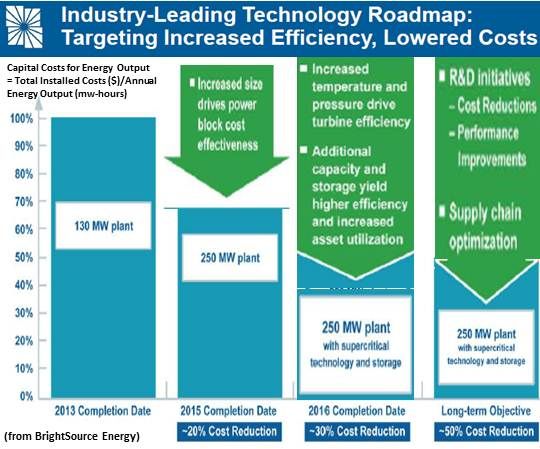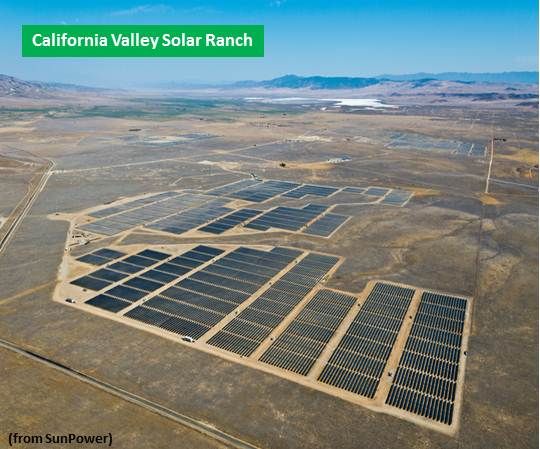The California Public Utilities Commission (CPUC) voted unanimously on October 25 to approve revised power purchase agreements (PPAs) between BrightSource Energy (BSE) and Southern California Edison (SCE) (NYSE:EIX) for electricity generated by one 250-megawatt unit of BSE’s proposed 500-megawatt Rio Mesa solar power tower project and one 250-megawatt unit of its proposed Sonoran West tower project. The CPUC also rejected three proposed BSE-SCE PPAs.
The rate designated by the renegotiated PPAs for purchase of the power is confidential. "Edison negotiated hard on behalf of their customers," BSE Government Affairs VP Joe Desmond said, “and got a significant increase in value and decrease in cost.”
The CPUC-approved PPAs lock in an estimated annual generation of 573 gigawatt-hours from each facility “for a term of twenty years with the option for SCE to extend the term to 25 years.” According to BSE, design specifications call for Rio Mesa to produce at least 573 gigawatt-hours per year and for Sonoran West, with storage, to produce at least 733 gigawatt-hours per year.
The revised PPA for Rio Mesa provides for BSE’s planned deployment of its second-generation technology. It will have a 250-foot-taller tower than in the first-generation, 372-megawatt Ivanpah plant now under construction, allowing for a more concentrated arrangement of heliostats that will reduce the land required to two-thirds of that needed for a comparable photovoltaic (PV) or power tower project.
The revised Sonoran West PPA provides for incorporation of the newer technology, as well as the first deployment of BSE’s steam-heated molten salts storage system. Stored generating capacity will give Sonoran West more production capacity and the flexibility to serve the grid in ways that help balance transmission system supply and demand and make electricity delivery more reliable, functions more typically associated with traditional power plants.
The CPUC-approved PPA calls for Sonoran West to have “a few hours” of generating capacity “when the thermal storage system has been charged and the sun is not shining.”
Perhaps most importantly, Rio Mesa and Sonoran West won PPAs despite not having Department of Energy loan guarantees. They will be the first U.S. concentrating solar power (CSP) projects built with only marketplace investment, state incentives, and the federal investment tax credit (ITC).
According to BSE, the contracts represent billions of dollars in direct investment and more than 2,000 construction jobs for California’s economically stressed Inland Empire region.

Of the rejected PPAs, Hunter explained, BSE planned in 2009 for seven contracts but, with the addition of storage capability in November 2011, one of the PPAs became extraneous, and Ivanpah’s PPA with SCE was previously finalized, along with two Pacific Gas and Electric (PG&E) (NYSE:PCG) PPAs. That left five pending at the CPUC.
“One of the two units at Rio Mesa was approved and one was denied. And the one unit at Sonoran West was approved,” Hunter said. “Two others at the planned Siberia site were denied.”
The CPUC’s concern was the ability to facilitate projects that move California toward its 33 percent renewables by 2020 goal, Desmond explained. This is “a workable plan that could be done, taking into account the need for deliverability, and including transmission and constructability, in time for qualifying for the ITC.”
The other three PPAs were unlikely to be fulfilled by the end of 2016, when the ITC will drop from 30 percent to 10 percent. “For a variety of reasons,” Desmond said, “but it comes down to transmission.”
BSE will continue working through the planning and permitting processes for the other sites. “We are talking to other utilities,” Desmond said. “Over time, people drop out of certain transmission queues. That changes which projects may be advanced.”
While BSE worked through the CPUC process, SunPower Corp. (NASDAQ: SPWR) brought three photovoltaic (PV) sites on-line across California.
The first twenty-two megawatts of the 250-megawatt California Valley Solar Ranch (CVSR) project, owned by NRG Energy, Inc. (NYSE: NRG), created approximately 350 jobs since construction started in September 2011 and is expected to add $315 million to the San Luis Obispo County economy over its two-year construction period.
CVSR, which will be one of the biggest PV solar plants in the world, has a 25-year PPA with PG&E. The full 250 megawatts are expected to be on-line by December 2013. Engineering, procurement and construction (EPC) for the SunPower designed project is being handled by Bechtel.
A 13.78-megawatt PV system at Naval Air Weapons Station China Lake, the U.S. Navy’s biggest solar installation, will generate over 30 percent of the facility’s annual energy load and cut its power costs an estimated $13 million over twenty years. It will use “SunPower's high-efficiency, Buy American-compliant solar panels,” SunPower reported, and SunPower’s modular solar power block that incorporates its tracker, cabling, inverter and operating system.
The facility’s MetLife (NYSE:MET) affiliate-owned, Navy-hosted and SunPower-designed, -built and -maintained system is backed by the first no-upfront-cost 20-year PPA through the Defense Department’s long-term energy procurement authority (US Code Section 2922A). It will allow the Navy to get electricity at up to 30 percent below present rates.
The 25-megawatt McHenry Solar Project, built for K Road under a Modesto Irrigation District contract, brought an estimated 100 construction jobs to the economically stressed Stanislaus County region.




